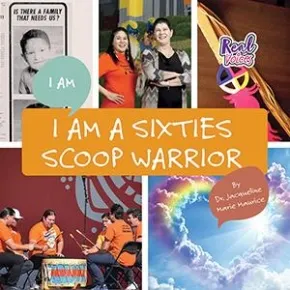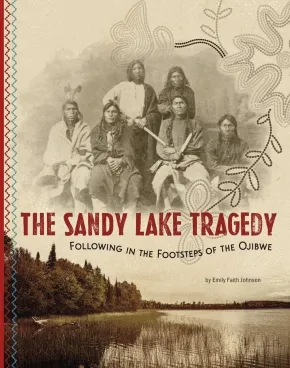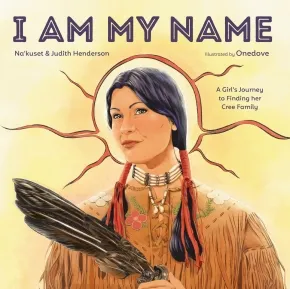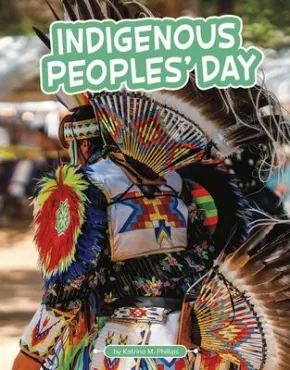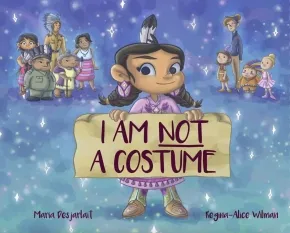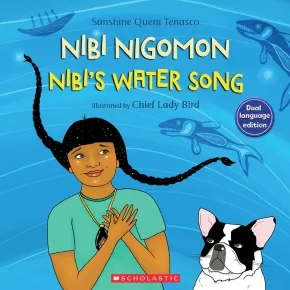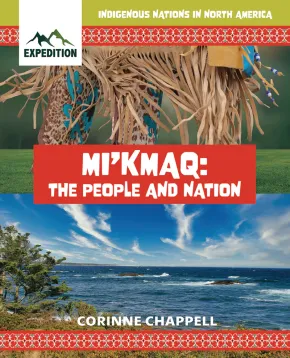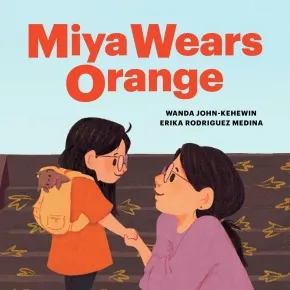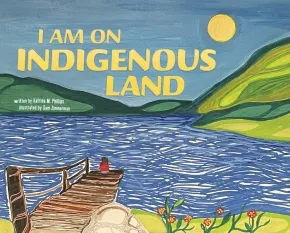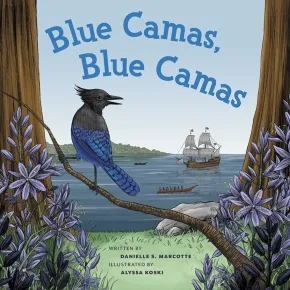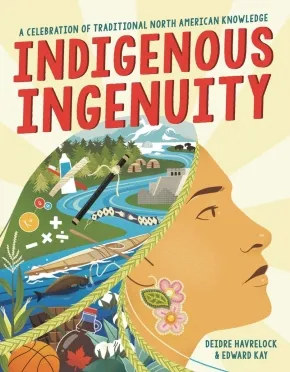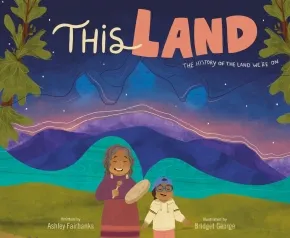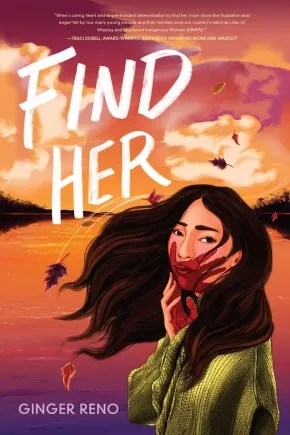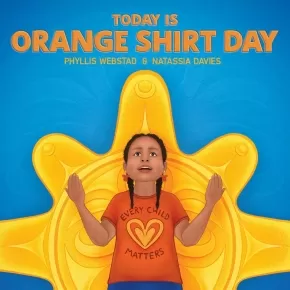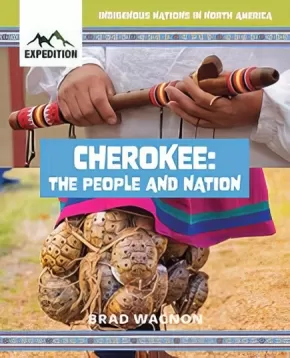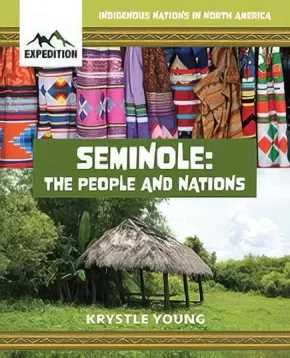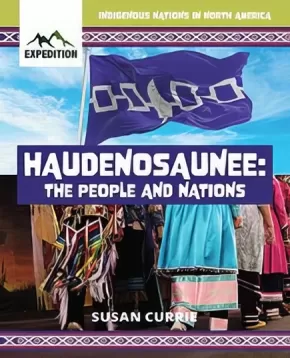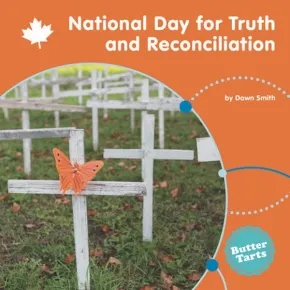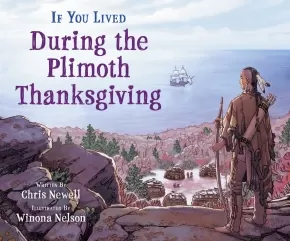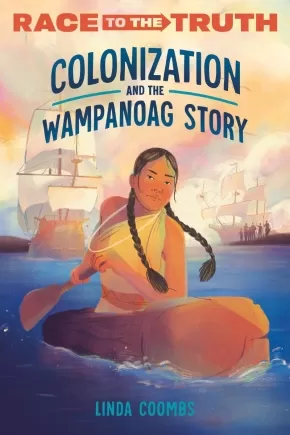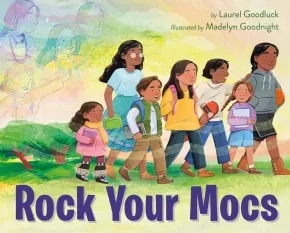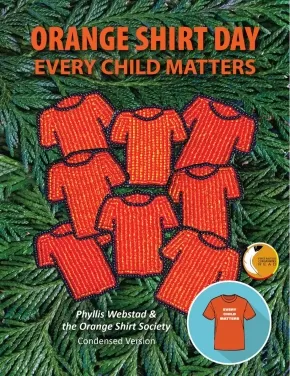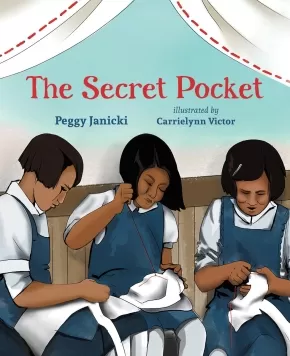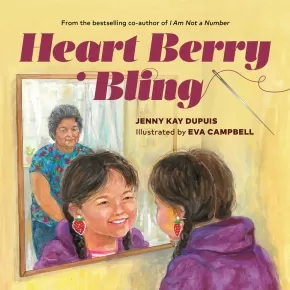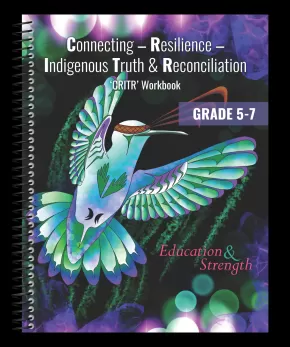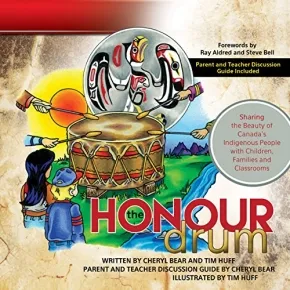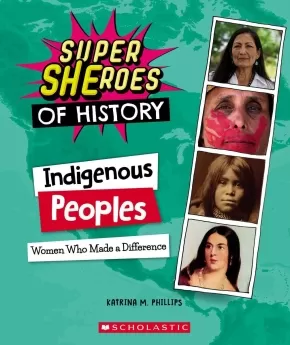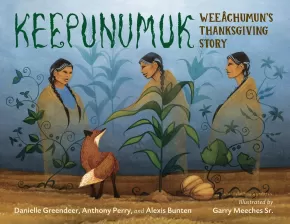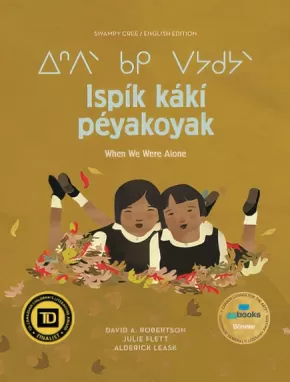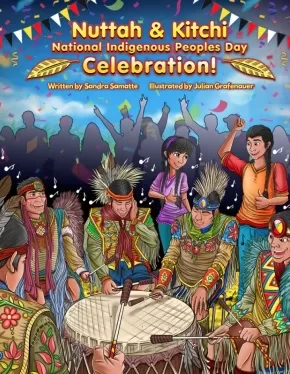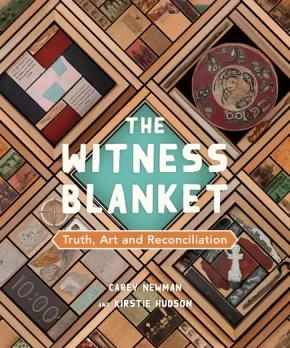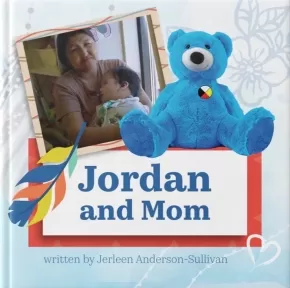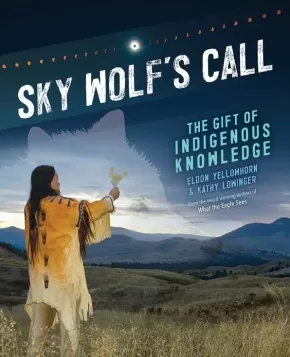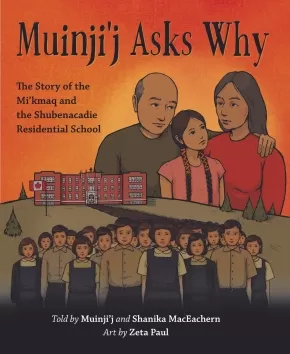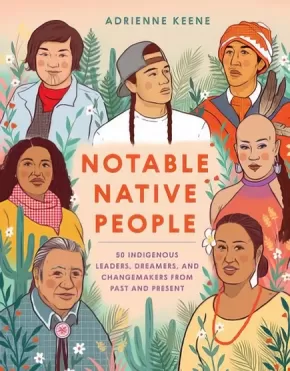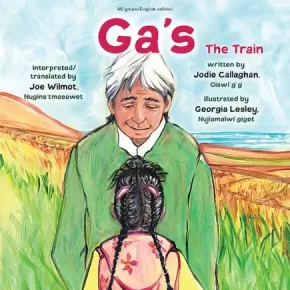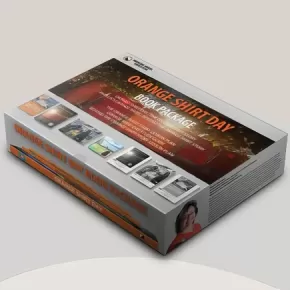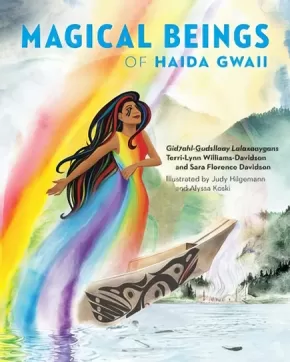
Indigenous Awareness
1
-
15
of
114 Results;
Sort By
Go To
of 8
I Am a Sixties Scoop Warrior
$17.95
Format:
Paperback
Text Content Territories:
Indigenous Canadian; Métis;
ISBN / Barcode: 9781774569153
Synopsis:
Synopsis:
The Sixties Scoop is a dark part of Canada's history. Learn more about this time from someone who lived it. Jacqueline tells us more about her time as a child in the Sixties Scoop.
Educator Information
Juvenile Nonfiction
Additional Information
24 pages | Paperback
The Sandy Lake Tragedy: Following in the Footsteps of the Ojibwe
$13.99
Format:
Paperback
Text Content Territories:
Indigenous American; Native American; Anishinaabeg; Ojibwe (Chippewa);
ISBN / Barcode: 9798875206146
Synopsis:
Synopsis:
In 1850, 5,000 Ojibwe people were forced to make a dangerous journey across the Midwest to get treaty payments owed to them from the U. S. Government. But the payments never came, and the Ojibwe had to travel back home through treacherous winter conditions and without the money or supplies they had been promised. More than 400 Ojibwe lost their lives in this event that is now known as the Ojibwe Trail of Tears. Compelling narrative and impactful images help to recount the injustices of this forced removal and explain how it happened, what the many consequences were, how the Ojibwe people responded, and why this tragedy is still vitally relevant today. Author Emily Faith Johnson (Sault St. Marie Chippewa member) shares this not-to-be-forgotten story with young readers and educators seeking a closer look at U.S. history.
Educator Information
Recommended for ages 8 to 12.
Additional Information
32 pages | 8.00" x 10.00" | Paperback
I Am My Name: A Girl's Journey to Finding Her Cree Family
$26.99
Artists:
Text Content Territories:
Indigenous Canadian; First Nations; Cree (Nehiyawak);
ISBN / Barcode: 9780593648766
Synopsis:
Synopsis:
An evocative autobiographical picture book about Cree activist Na'kuset's life as a young girl taken from her home along with thousands of other indigenous children during the 1960s, and the journey of discovery that leads her to reclaim her life and culture.
I have come from somewhere else, where
I am Cree and I have a big sister
and another name.
One night, a very young girl was removed from her home during Canada’s Sixties Scoop, which tore children from their Indigenous communities. She woke in a new home, with a new family and a new name—her former life fading to a ghost of a memory. The only place she ever felt like she fit in was with her grandmother—her Bubbie—who listened to her and made her chicken soup and wrapped her in her loving arms. Until one day…the girl discovered the truth. And her beloved Bubbie helped her on her journey to claim her identity, her voice—and her name.
Together, Na'kuset and Judith Henderson tell the powerful story of the Indigenous experience for a child during the Sixities Scoop. Cree illustrator Onedove shared how inspired they are by Na'kuset's story and activism, and that is made evident in the tender and vivid illustrations that bring Na'kuset's story to life.
Educator Information
Recommendations for ages 6 to 9.
Lexile measure: 450L
Fountas & Pinnell Text Level Gradient: O
Additional Information
40 pages | 9.50" x 9.50" | Hardcover
Indigenous Peoples' Day
$11.99
Format:
Paperback
Text Content Territories:
Indigenous American;
ISBN / Barcode: 9781663926340
Synopsis:
Synopsis:
Indigenous Peoples' Day is about celebrating! The second Monday in October is a day to honor Native American people, their histories, and cultures. People mark the day with food, dancing, and songs. Readers will discover how a shared holiday can have multiple traditions and be celebrated in all sorts of ways.
Awards
- 2022 American Indian Library Association winner
Educator Information
Recommended for ages 5 to 8.
This book is about Indigenous Peoples' Day in the United States.
Additional Information
32 pages | 7.00" x 9.00" | Paperback
I Am Not a Costume
$22.99
Artists:
Format:
Hardcover
Text Content Territories:
Indigenous American; Native American; Anishinaabeg; Ojibwe (Chippewa);
ISBN / Barcode: 9781778540738
Synopsis:
Synopsis:
I am not a costume.
Ayasha’s school is having a costume party and she is so excited!
But when Ayasha arrives at school and sees other students wearing fake regalia, she is confused and upset. She doesn’t understand why they think her culture is a costume. Ayasha turns to her family and together they come up with a way to teach her classmates about her culture and how to honor her people respectfully.
Educator Information
Recommended for ages 6+.
Additional Information
32 pages | 8.50" x 11.00" | Hardcover
Celebrating Potlatches
$21.95
Artists:
Format:
Hardcover
Text Content Territories:
Indigenous Canadian; First Nations; Tsimshian (Ts'msyen); Nisga'a;
ISBN / Barcode: 9781771746564
Synopsis:
Synopsis:
“Papa, what is a Potlatch?”
Inspired by Ts’msyen Chief William Beynon’s historic notebooks on Potlatches in the Gitxsan village of Gitsegukla, Celebrating Potlatches pairs intergenerational storytelling with beautiful illustrations to honour Indigenous traditions. From the award-winning author of Oolichan Moon and the accomplished illustrator of Be a Good Ancestor, this book recounts the 1885 Potlatch ban and the resilience of the communities who fought to keep their traditions alive.
Reviews
“Heartfelt and timely, Celebrating Potlatches gifts readers with cultural teachings through an intergenerational account of Indigenous resilience. This book is a beautiful tribute to the author’s great-grandfather, William Beynon, whose life’s work documenting oral histories of Sm’algya̱x-speaking Peoples and their Potlatches continues to be foundational to our cultural resurgence today.” – Sm Łoodm ‘Nüüsm (Dr. Mique’l Dangeli), Sm’algya̱x language expert and Assistant Professor of Indigenous Arts at the University of Victoria
“This beautiful book shares the importance of community, culture, and identity. As you make your way through the pictures and words, they bring you to an understanding of how important the Potlatch ceremony was and continues to be for Indigenous Peoples.” – Carolyn Roberts, educator, speaker, and author of Re-Storying Education
Educator Information
Recommended for ages 4 to 8.
Through this conversational historic account, readers can learn alongside the narrator as his Papa shares his wisdom about the rich history of the Potlatch.
Curriculum Connections
- Early literacy – listening, reading, and discussing
- Art – traditional Indigenous art, drumming, and regalia
- Social studies – the 1885 Potlatch ban, history of Indigenous Peoples, connection to community
- Social responsibility – uplifting ourselves and others, honouring traditions
- Indigenous knowledge and traditions – traditional teachings, Potlatch ceremonies, intergenerational storytelling
Two free, downloadable lesson plans—one for kindergarten to Grade 1 and one for Grades 2 to 3—provide connections to Social Studies curriculum.
Additional Information
32 Pages | 10" x 8.5" | Hardcover
Anishinaabek: The People and Nations
$16.95
Format:
Paperback
Text Content Territories:
Indigenous Canadian; First Nations; Anishinaabeg;
ISBN / Barcode: 9781774565100
Synopsis:
Synopsis:
The Anishinaabek are a rich nation with teachings and practices passed down from generation to generation. Explore more about the people and nations through Anishinaabek author Jennifer Meness.
Educator & Series Information
This book is part of the Indigenous Nations in North America series.
Additional Information
32 Pages | Paperback
Nibi nigomon/Nibi's Water Song
$8.99
Format:
Paperback
Text Content Territories:
Indigenous Canadian; First Nations; Anishinaabeg;
ISBN / Barcode: 9781039700673
Synopsis:
Synopsis:
Nibi is determined to bring clean water to her community.
Nibi is the Anishinabemowin word for water. In Nibi’s Water Song, Nibi is an Indigenous girl on the search for clean water to drink. Though she is faced with repeated obstacles, Nibi’s joyful and determined energy becomes a catalyst for change and action as her community rallies around her to make clean drinking water available for all.
First published in 2020, Nibi’s Water Song was shortlisted for both the IODE Jean Throop Award and longlisted for the First Nations Communities READ Award. This dual-language edition presents the text in both English and Anishinabemowin.
Educator Information
Recommended for ages 4-8.
Dual-language: English and Anishinabemowin
Translated by Tina Nottaway. Tina is an Algonquin Anicinabe Ikwe artist and translator from Rapid Lake, Quebec. She is fluent in her language, Anicinabemowin. Tina is also a crafter and facilitates workshops on moccasin making, birchbark basket making and other cultural activities.
This resource is available in English: Nibi's Water Song
This resource is also available in French: Nibi a soif, très soif
Additional Information
32 pages | 9.51" x 9.51" | Paperback
Mi'kmaq: The People and Nation
$16.95
Format:
Paperback
Text Content Territories:
Indigenous Canadian; First Nations; Mi'kmaq (Mi'gmaq);
ISBN / Barcode: 9781774567708
Synopsis:
Synopsis:
The Mi'kmaq have many practices in their culture which make them unique. Discover more about the people and nation through Mi'kmaq author Corinne Chappell.
Educator & Series Information
This book is part of the Indigenous Nations in North America series.
Additional Information
32 Pages | Paperback
Miya Wears Orange
$21.95
Artists:
Format:
Hardcover
Text Content Territories:
Indigenous Canadian; First Nations; Cree (Nehiyawak);
ISBN / Barcode: 9781774921258
Synopsis:
Synopsis:
A beautifully illustrated book that gently explores the complicated feelings a young girl experiences as she learns about tragedy and injustice.
Miya loves her school and she especially loves storytime. One day, her teacher shares a story about a little girl who was taken away to a residential school. The little girl wasn’t allowed to go home. Her hair was cut and she wasn’t allowed to keep her favourite doll. She was taken away from her family because she was Indigenous, just like Miya!
Miya worries the same thing will happen to her. Her mom tells her that Indigenous girls and boys aren’t forced to leave their families anymore. Miya is relieved, but she is still sad. What can she do about these feelings?
Reviews
"A moving and important story that deftly explores the fear a little Indigenous girl feels when she learns the truth about residential schools. Miya finds solace in her mom’s words, and readers will too. A sensitive explanation of residential schools that prioritizes the emotional safety of all readers, especially Indigenous children."— Jen Moss, lecturer at UBC's School of Creative Writing
"opens the door to an important discussion about residential schools" - School Library Journal
Educator Information
Recommended for ages 6 to 8.
In this story, a young girl named Miya feels scared and sad after learning about residential schools, but she learns how to cope with the help of her mother.
A gentle story about big feelings and finding courage.
Big Ideas: Social-Emotional Learning: Emotions and Feelings; Social Justice: Intergenerational Trauma, Residential Schools.
This book is available in French: Le Chandail orange de Miya.
Additional Information
40 pages | 8.50" x 8.50" | Hardcover
I Am on Indigenous Land
$25.99
Format:
Hardcover
Text Content Territories:
Indigenous American; Native American; Shawnee; Seminole; Salish; Coast Salish; Nisqually; Navajo (Diné); Ho-Chunk (Winnebago); Haudenosaunee (Iroquois); Tuscarora; Chickasaw; Blackfoot Confederacy (Siksikaitsitapi); Anishinaabeg; Ojibwe (Chippewa); Indigenous Caribbean; Taino;
ISBN / Barcode: 9781684363087
Synopsis:
Synopsis:
With simple, lyrical text and vibrant panoramic illustrations, this picture book explores the beauty and resources of thirteen ancestral Indigenous lands and how we all use those lands each day. Simple poetry and portrayals of children and families enjoying rivers, bike paths, beaches, and parks show how everyday activities can include honoring Indigenous nations and cultures.
Author Katrina Phillips (Ojibwe citizen) and illustrator Sam Zimmerman (Ojibwe direct descendant) together have crafted a loving tribute that gently demonstrates recognition and acknowledgement of the nations of people who first called these lands home.
Educator Information
Recommended for ages 3 to 9.
Additional Information
32 pages | 10.00" x 8.00" | Hardcover
Blue Camas, Blue Camas (PB)
$14.95
Format:
Paperback
Text Content Territories:
Indigenous Canadian; First Nations; Salish; Coast Salish; Songhees (Lekwungen);
ISBN / Barcode: 9781772035247
Synopsis:
Synopsis:
The captivating story of how the Blue Camas, a flower that has been cultivated on Canada’s west coast since time immemorial, came to symbolize the meeting of two contrasting ways of life and the perseverance of traditional knowledge against all odds.
Blue Camas, Blue Camas tells the story of a flower that is native to the Northwest Coast of North America. For thousands of years, it has been considered a sacred and valuable plant by the Indigenous Peoples of this region, who harvested and traded Blue Camas bulbs all along the west coast. At the height of this period, meadows would come alive with the bright wildflowers, which would attract dozens of species of butterflies and birds, and entire villages would work together to harvest the plant and ensure its continued growth.
When Europeans arrived and began to colonize the land, they did not see the value of the Blue Camas plant, and in fact saw the meadows where the plant had been harvested as ideal terrain to grow their own crops. The story takes place at the point of contact between a Lkwungen community and a group of Irish settlers, who see the land in very different ways.
This beautifully illustrated picture book is an ode to a way of life that was threatened and nearly destroyed through miscommunication and colonization. It also raises awareness for food rights, biodiversity, and the preservation of ecosystems, offering children and teachers the opportunity to discuss these important themes in an open and constructive way.
Reviews
"Blue Camas, Blue Camas is a captivating story revealing the overlooked history of colonial contact and its impact on Indigenous communities. Through vivid storytelling and diverse voices, it emphasizes land stewardship, cultural heritage, and fostering empathy, making it a valuable resource for children.”—Samantha Beynon, author of Oolichan Moon
“A beautiful story and an important narrative about the timeline of colonial contact . . . I am happy to share this book with my children.”—Sen’ákw, Senaqwila Wyss, Squamish Nation ethnobotanist
“Danielle S. Marcotte offers a rich, historical perspective of the amazing Blue Camas plant through the eyes of a First Nations family and a settler family.”—Teoni Spathelfer, Heiltsuk author of the Little Wolf Series
“This beautiful story weaves together a rich and important narrative. Family, nature, and the village are all intertwined, with the camas at the centre of it all. So simple and yet so poignant and true!”—Robert "Lucky" Budd, co-author (with Roy Henry Vickers) of the Northwest Coast Legends Series and A Is for Anemone: A First West Coast Alphabet
Educator Information
Recommended for ages 4 to 8.
Additional Information
48 pages | 9.00" x 9.00" | Paperback
Indigenous Ingenuity: A Celebration of Traditional North American Knowledge (PB)
$12.99
Artists:
Format:
Paperback
ISBN / Barcode: 9780316413435
Synopsis:
Synopsis:
Celebrate Indigenous thinkers and inventions with this beautifully designed, award-winning interactive nonfiction book—perfect for fans of Braiding Sweetgrass.
Corn. Chocolate. Fishing hooks. Boats that float. Insulated double-walled construction. Recorded history and folklore. Life-saving disinfectant. Forest fire management. Our lives would be unrecognizable without these, and countless other, scientific discoveries and technological inventions from Indigenous North Americans.
Spanning topics from transportation to civil engineering, hunting technologies, astronomy, brain surgery, architecture, and agriculture, Indigenous Ingenuity is a wide-ranging STEM offering that answers the call for Indigenous nonfiction by reappropriating hidden history. The book includes fun, simple activities and experiments that kids can do to better understand and enjoy the principles used by Indigenous inventors. Readers of all ages are invited to celebrate traditional North American Indigenous innovation, and to embrace the mindset of reciprocity, environmental responsibility, and the interconnectedness of all life.
Reviews
"An astonishing, exuberant treasure trove of history, science and hands-on activities that repeatedly begs the question: "Why didn't I know this?" Essential for kids and adults. We need this book." —Candace Fleming, award-winning author of The Rise and Fall of Charles Lindbergh and The Family Romanov
"This book will amaze readers and teachers as it demonstrates how pervasive and critical the history of Indigenous people is. A completely unique and important narrative not to be missed; readers and teachers will come away with a new appreciation for the myriad contributions Indigenous people have made."—SLJ, starred review
"A conversational tone invites readers to engage with this monumental collection . . . Curious readers will learn facts unique to individual tribal groups while gaining knowledge of STEM/STEAM concepts. An ambitious, appealing, and accessible work documenting and protecting valuable knowledge."—Kirkus Reviews
"Engaging and informative, this will be welcomed by both STEM and social studies curricula to help to correct prevailing narratives about Indigenous technology."—Booklist, starred review
"Via authoritative, meticulously researched prose, the creators detail Native peoples’ significant strides in scientific pursuits . . . [and] showcase Native tribes’ continual and enduring impact. Photographs, as well as interactive activities detailing recipes and science experiments, feature throughout, lending a hands-on approach to this clear and concise work."—Publishers Weekly
"This book is a valuable contribution to efforts to decolonize learning and introduce readers to the breadth of indigenous knowledge as practiced in widely disparate geographic zones."—Canadian Review of Materials
"An engaging and cleverly compiled guide to North American and Mesoamerican Indigenous innovation. STEM topics (housing, medicine, clothing, agriculture, and hunting among them) are compellingly and conversationally discussed."—Shelf Awareness
Educator Information
Recommended for ages 8 to 12.
Fountas & Pinnell Text Level Gradient: Z
Additional Information
288 pages | 6.95" x 9.00" | Paperback
This Land: The History of the Land We're On
$24.99
Format:
Hardcover
Text Content Territories:
Indigenous American; Native American; Anishinaabeg;
ISBN / Barcode: 9780593651445
Synopsis:Lexile measure: AD630L
Synopsis:
This land is your land now, but who did it belong to before? This engaging primer about native lands invites kids to trace history and explore their communities.
Before my family lived in this house, a different family did, and before them, another family, and another before them. And before that, the family who that lived here lived not in a house, but a wigwam. Who lived where you are before you got there?
This Land teaches readers that American land, from our backyards to our schools to Disney World, are the traditional homelands of many Indigenous nations. This Land will spark curiosity and encourage readers to explore the history of the places they live and the people who have lived there throughout time and today.
Reviews
"This work aptly communicates the issue of land acknowledgments . . . A memorable message." —Publishers Weekly, starred review
"A stirring tale that fosters respect for Native peoples." —Kirkus Reviews
Educator Information
Recommended for ages 4 to 8.
Fountas & Pinnell Text Level Gradient: M
Additional Information
40 pages | 11.37" x 9.37" | Hardcover
Find Her
$24.49
Format:
Hardcover
Text Content Territories:
Indigenous American; Native American; Cherokee;
ISBN / Barcode: 9780823454808
Synopsis:
Synopsis:
Five years, three months, and twelve days.
That’s how long Wren’s mother has been missing.
In dreams, Wren can see her again: her eyes, her hair, her smile. She can even hear her laugh. Her mother, one of hundreds of Native Americans considered missing or murdered in Oklahoma. Sometimes it seems like Wren and her grandmother are the only people still looking. Even more frustrating, Wren's overprotective father won't talk about it.
Wren refuses to give up, though. And an opportunity to find lost pets seems like a real way to hone her detective skills. But everything changes when one of the missing pets is found badly hurt. Soon, there are others.
With help from an unlikely friend, Wren vows to unmask whoever is behind the animal abuse. If she can do this, maybe she can do the same for her mother's case. She'll just have to keep it secret from her father who will certainly put an end to all her sleuthing if he finds out.
Find Her explores the crisis of missing Indigenous women from the perspective of a sensitive young Cherokee girl who yearns to find her mother, while also navigating a chilling town mystery, a new friendship, and a family in need of healing.
Awards
- A Junior Library Guild Gold Standard Selection
Reviews
"Via crisp prose, Reno meshes plot threads involving abandoned shelter pets and a mystery surrounding a locator on Wren’s grandmother’s keys, which emphasize the futility Wren feels in trying to find someone who seems unreachable."—Publishers Weekly, Starred Review
"A dramatic and captivating call for attention."—Kirkus Reviews
"Cherokee writer Reno crafts a powerful debut centering an important issue affecting Indigenous women and families; a strong purchase for all middle schools."—School Library Journal
"Wren's caring heart and single-minded determination to find her mom shows the frustration and anger felt by too many young people and their families over our country's national crisis of Missing and Murdered Indigenous Women (MMIW)."—Traci Sorell, award-winning author of Indian No More and Mascot
"Find Her is a compelling novel written with sensitivity by gifted Cherokee writer Ginger Reno. In this contemporary story of Wren and her family in Cherokee Nation, Reno addresses the injustice of so many missing and murdered indigenous relatives and the heartbreak and hope that comes with not knowing. Find a place on your shelves for Find Her."—Andrea L. Rogers, award-winning author of Man Made Monsters
Educator Information
Recommended for ages 10+
Additional Information
|
Today is Orange Shirt Day (BB)
$13.95
Artists:
Format:
Board Book
Text Content Territories:
Indigenous Canadian; First Nations; Salish; Interior Salish; Secwepemc (Shuswap); Stswecem'c Xgat'tem;
Grade Levels: Preschool;
ISBN / Barcode: 9781778540363
Synopsis:
Synopsis:
Today, we gather together Today, we listen Today, we learn Today, we open our hearts
A first conversation about the importance of Orange Shirt Day - Every Child Matters and what little ones can expect to see and do on Orange Shirt Day - The National Day for Truth and Reconciliation.
An authentic, age-appropriate touch-and-feel board book designed for ages 0-3, written by the founder of the Orange Shirt Day movement and author of award-winning picture book Every Child Matters.
Orange Shirt Day is a day recognized annually on September 30th to honour Residential School Survivors, their families, and the children who did not come home.
Awards
- Silver IPPA Book Award Winner (First Nations/Indigenous Communities category)
Educator Information
Recommended for ages 0 to 3.
This book is available in French: La Journée du chandail orange, c'est aujourd'hui (BB)
Additional Information
24 pages | 7.00" x 7.00" | Board book
Cherokee: The People and Nation
$16.95
Format:
Paperback
Text Content Territories:
Indigenous American; Native American; Cherokee;
ISBN / Barcode: 9781774565117
Synopsis:
Synopsis:
In this book, discover the difficult journey of The Cherokee people. How they came to North America and how they were then removed with other Nations through The Trail of Tears. Learn about the seven Cherokee clans. Their culture, traditions, and language as it was the first Indigenous language put into writing.
Educator & Series Information
This book is part of the Indigenous Nations in North America series.
Additional Information
32 Pages | Paperback
Métis: The People and Nation
$16.95
Format:
Paperback
Text Content Territories:
Indigenous Canadian; Métis;
ISBN / Barcode: 9781774565131
Synopsis:
Synopsis:
The Metis peoples have a rich and expansive history here in Canada and beyond. Learn more about their hertiage, teachings, traditions which have traveled generations and generations.
Educator & Series Information
This book is part of the Indigenous Nations in North America series.
Additional Information
32 Pages | Paperback
Seminole: The People and Nations
$16.95
Format:
Paperback
Text Content Territories:
Indigenous American; Native American; Seminole;
ISBN / Barcode: 9781774565148
Synopsis:
Synopsis:
Orginating from Florida, the Seminole nation has a deep history in North America. Discover more about the Seminole nation, their traditions and story.
Educator & Series Information
This book is part of the Indigenous Nations in North America series.
Additional Information
32 Pages | Paperback
Haudenosaunee: The People and Nations
$16.95
Format:
Paperback
Text Content Territories:
Indigenous Canadian; First Nations; Haudenosaunee (Iroquois);
ISBN / Barcode: 9781774565124
Synopsis:
Synopsis:
The Haudenosaunee, like many Indigenous Nations and communities across North America, have their own history and culture. Discover the Peacemaker Story, which explains how the Confederacy was created. Learn about historical facts and their effects on present times. Get to know Haudenosaunee people who give thanks everyday and have many stories and traditions to tell.
Educator & Series Information
This book is part of the Indigenous Nations in North America series.
Additional Information
32 Pages | Paperback
National Day for Truth and Reconciliation
$15.95
Format:
Paperback
Text Content Territories:
Indigenous Canadian; First Nations; Nuu-chah-nulth (Nootka);
ISBN / Barcode: 9781774564950
Synopsis:
Synopsis:
Readers are invited to jump into a canoe to learn about residential schools in Canada and the special day for truth and reconciliation. Author Dawn Sii-yaa-ilth-supt Smith is Nuu-chah-nulth and attended Tsartlip Indian Day School in British Columbia. She shares her story and the importance of truth-telling and reconciliation in Canada.
Educator & Series Information
Juvenile Nonfiction
This book is part of the Indigenous Communities in Canada series.
This book is available in French: La Journee nationale de la verite et de la reconciliation
Additional Information
24 Pages
If You Lived During the Plimoth Thanksgiving
$11.99
Format:
Paperback
Text Content Territories:
Indigenous American; Native American; Wampanoag (Wôpanâak);
ISBN / Barcode: 9781338726367
Synopsis:
Synopsis:
What do you know about the thanksgiving feast at Plimoth?
What if you lived in a different time and place? What would you wear? What would you eat? How would your daily life be different?
Scholastic's If You Lived... series answers all of kids' most important questions about events in American history. With a question and answer format, kid-friendly artwork, and engaging information, this series is the perfect partner for the classroom and for history-loving readers.
What if you lived when the English colonists and the Wampanoag people shared a feast at Plimoth? What would you have worn? What would you have eaten? What was the true story of the feast that we now know as the first Thanksgiving and how did it become a national holiday?
Chris Newell answers all these questions and more in this comprehensive dive into the feast at Plimoth and the history leading up to it. Carefully crafted to explore both sides of this historical event, this book is a great choice for Thanksgiving units, and for teaching children about this popular holiday.
Reviews
"A welcome addition to the picture book history collection. ...The text does a remarkable job of giving larger context to the complexity of Indigenous life prior to colonization...This essential book should replace many established titles on the shelf." --School Library Journal (starred review)
"A measured corrective to pervasive myths about what is often referred to as the "first Thanksgiving." ...The lens Newell offers is a Native one, describing how the Wampanoag and other Native peoples received the English rather than the other way around. ...Essential." --Kirkus Reviews (starred review)
"A measured corrective to pervasive myths about what is often referred to as the "first Thanksgiving." ...The lens Newell offers is a Native one, describing how the Wampanoag and other Native peoples received the English rather than the other way around. ...Essential." --Kirkus Reviews (starred review)
Educator Information
Recommended for ages 7 to 10.
Additional Information
96 pages | 9.00" x 7.50" | Paperback
Discovering and Understanding The Métis
$24.99
Format:
Hardcover
Text Content Territories:
Indigenous Canadian; Métis;
ISBN / Barcode: 9782898244766
Synopsis:
Synopsis:
From their origins to their lives today, the Métis have so many things to tell us! Thanks to beautiful photos, illustrations, and texts written by experts, we can learn and understand more about the rich culture of the Métis.
Educator & Series Information
Recommended for ages 7 to 12.
This book is part of the Discovering and Understanding series.
Additional Information
32 pages | 8.66" x 10.62" | Hardcover
What Is Your Name? A Book about Inuit Naming Practices
$14.95
Artists:
Format:
Paperback
Text Content Territories:
Indigenous Canadian; Inuit;
Grade Levels: Preschool; Kindergarten;
ISBN / Barcode: 9781774506561
Synopsis:
Synopsis:
Does your name have a story?
Kukik is named after her great-grandmother. Naullaq’s name honours his uncle. Panigusiq and Tegeapak have stories behind their names, too. Naming is an important practice to Inuit. This book follows four Inuit children as they explain the meanings of their names in simple language for young children to enjoy.
Written by four Inuit children who share their own stories about how they got their names, this bilingual storybook offers a unique look into Inuit traditional naming practices.
Educator Information
Recommended for ages 3 to 5.
Dual-Language: English and Inuktitut
This book teaches children about the important practice of Inuit traditional naming.
Additional Information
34 pages | 10.00" x 8.00" | Paperback
Colonization and the Wampanoag Story
$11.99
Format:
Paperback
Text Content Territories:
Indigenous American; Native American; Wampanoag (Wôpanâak);
ISBN / Barcode: 9780593480434
Synopsis:
Synopsis:
Until now, you've only heard one side of the story: the "discovery" of America told by Christopher Columbus, the Pilgrims, and the Colonists. Here's the true story of America from the Indigenous perspective.
When you think about the beginning of the American story, what comes to mind? Three ships in 1492, or perhaps buckled hats and shoes stepping off of the Mayflower, ready to start a new country. But the truth is, Christopher Columbus, the Pilgrims, and the Colonists didn't arrive to a vast, empty land ready to be developed. They arrived to find people and communities living in harmony with the land they had inhabited for thousands of years, and they quickly disrupted everything they saw.
From its "discovery" by Europeans to the first Thanksgiving, the story of America's earliest days has been carefully misrepresented. Told from the perspective of the New England Indigenous Nations that these outsiders found when they arrived, this is the true story of how America as we know it today began.
Reviews
"A poignant and powerful look at identity, change, and resiliency." —Kirkus Reviews
Educator Information
Recommended for ages 10+.
Additional Information
272 pages | 5.50" x 8.31" | Paperback
Rock Your Mocs
$24.99
Artists:
Format:
Hardcover
Text Content Territories:
Indigenous American; Indigenous Canadian;
ISBN / Barcode: 9780063099890
Synopsis:
Synopsis:
In this happy, vibrant tribute to Rock Your Mocs Day, observed yearly on November 15, author Laurel Goodluck (Mandan, Hidatsa, and Tsimshian) and artist Madelyn Goodnight (Chickasaw) celebrate the joy and power of wearing moccasins—and the Native pride that comes with them. A perfect book for Native American Heritage Month, and all year round!
We’re stepping out
and kicking it up.
Wearing beauty on their feet—
as art, as tradition,
with style, with pride—
kids from different Native Nations know
every day is a day to ROCK YOUR MOCS!
This book contains an author’s note with additional information about moccasins and Rock Your Mocs day, for readers curious to learn more about intertribal pride and the joy found in different Native identities! Rock Your Mocs Day has now been extended to a week in November, and during that week, kids from all over the United States and North America join together to show pride in their heritage.
Educator Information
Recommended for ages 4 to 8.
Additional Information
32 pages | 10.00" x 8.00" | Hardcover
Orange Shirt Day: September 30th: Revised Edition
$32.99
Format:
Hardcover
Text Content Territories:
Indigenous Canadian; First Nations; Inuit; Métis;
ISBN / Barcode: 9781778540141
Synopsis:
Synopsis:
Orange Shirt Day, observed annually on September 30th, is also known as the National Day for Truth and Reconciliation. It is an official day to honour Residential School Survivors and their families, and to remember the children who did not come home. What was initially envisioned as a way to keep the conversations going about all aspects of Residential Schools in Williams Lake and the Cariboo Region of British Columbia, Canada, has now expanded into a movement across Turtle Island and beyond. Orange Shirt Day: September 30th aims to create champions who will walk a path of reconciliation and promote the message that 'Every Child Matters'. This award-winning book explores a number of important topics including the historical, generational, and continual impacts of Residential Schools on Indigenous Peoples, the journey of the Orange Shirt Day movement, and how you can effectively participate in the National Day for Truth and Reconciliation. With end of chapter reflection questions and a series of student art submissions, readers are guided to explore how they, and others, view and participate in Residential School reconciliation.
Awards
- 2021 First Nation Communities Read 2021 Winner
Educator Information
Recommended Ages: 10+
Orange Shirt Day was inspired by the story of a survivor named Phyllis Webstad. When Phyllis was 6 years old she went to residential school for the first time wearing a brand new shiny orange shirt. When she arrived at the school her shirt was taken away and never to be seen again. To Phyllis the colour orange was a symbol that she did not matter. Today she has learned to accept the colour and even have fun with it and now the orange shirt has become a symbol of hope and reconciliation. By wearing an orange shirt on Orange Shirt Day, you make a powerful statement that residential schools were wrong and commit to the concept that EVERY CHILD MATTERS.
The Orange Shirt Society is a non-profit organization with its home in Williams Lake, BC where Orange Shirt Day began in 2013. The society has both Indigenous and non-Indigenous board members, and one of the editors of this book, Phyllis Webstad, is Indigenous. Therefore, the Authentic Indigenous Text label has been applied. It is up to readers to determine if this book is authentic for their purposes.
This is the Revised 2023, 2nd Edition
Additional Information
156 pages | 8.23" x 11.06" | Revised, 2nd Edition
Powwow Dancing With Family (PB)
 $16.95
$16.95

Artists:
Format:
Paperback
Text Content Territories:
Indigenous Canadian; First Nations; Salish; Interior Salish; Secwepemc (Shuswap);
ISBN / Barcode: 9781771746281
Synopsis:
Synopsis:
Drumming, singing, and dancing are all part of being at a Powwow. Perry and his family travel all over North America to participate in these family and community gatherings. Join Perry’s two boys as they share their treasured memories of being at Powwows with their family and learning how to dance.
Reviews
“Lavishly illustrated with photographs, vivid sketches, and ledger art, Powwow Dancing With Family provides a detailed description of each stage of the Powwow, historical and contemporary aspects of the Powwow, and pays homage to Indigenous culture and customs. This informative resource will support studies of Indigenous culture, history, traditions, community, art, and family lifestyle.” – ERAC Review, May 2019
Educator Information
Includes three pages of educational material on Powwows with information found under these headings:
- What is a Powwow?
- Powwow Regalia
- Powwow Dances
About Perry Smith's Ledger Art:
Ledger Art is an art form that was developed in the mid 1800s to early 1900s by the Plains First Nations during a time when reserves were being established across North America. The ledger books were acquired in trade, war, or raids. New art supplies were also introduced: coloured pencils, crayons, and occasionally water paints. The new supplies were favoured by artists over the traditional bone and stick brushes. Many of the artworks within these ledger books display a traditional way of life, before assimilation. Today these artworks are greatly valued for the historical perspective that they offer.
Additional Information
32 pages | 8" x 8" | ISBN: 9781771746281 | Paperback
Orange Shirt Day: Every Child Matters: Condensed Edition
$19.99
Format:
Paperback
Text Content Territories:
Indigenous Canadian; First Nations; Inuit; Métis;
ISBN / Barcode: 9781778540158
Synopsis:
Synopsis:
A special abridged version of the award-winning book Orange Shirt Day: September 30th.
Orange Shirt Day, observed annually on September 30th, is also known as the National Day for Truth and Reconciliation. It is an official day to honour Residential School Survivors and their families, and to remember the children who did not come home. What was initially envisioned as a way to keep the conversations going about all aspects of Residential Schools in Williams Lake and the Cariboo Region of British Columbia, Canada, has now expanded into a movement across Turtle Island and beyond.
Orange Shirt Day: Every Child Matters aims to create champions who will walk a path of reconciliation and promote the message that 'Every Child Matters'. This version also explores a number of important topics including the historical, generational, and continual impacts of Residential Schools on Indigenous Peoples, the journey of the Orange Shirt Day movement, and how you can effectively participate in the National Day for Truth and Reconciliation. With end-of-chapter reflection questions and a series of student art submissions, readers are guided to explore how they, and others, view and participate in Residential School reconciliation.
Educator Information
Recommended for Young Adults (ages 10+)
This is an abridged version (condensed version) of Orange Shirt Day: September 30th.
This book is available in French: La journee du chandail orange: Chaque enfant compte
Additional Information
108 pages | 8.50" x 11.00" | Paperback
Nutshimit: In the Woods
$22.99
Artists:
Format:
Hardcover
Text Content Territories:
Indigenous Canadian; First Nations; Innu (Montagnais-Naskapi); Ekuanitshit; Inuit; Métis;
ISBN / Barcode: 9781039701809
Synopsis:
Synopsis:
In this immersive first-person account, Innu author Melissa Mollen Dupuis teams up with award-winning author and illustrator Elise Gravel to take readers on a journey through Innu culture, from creation legends to life today.
The Innu word Nutshimit signifies the physical and social space to practice traditional activities and language. Join author Melissa Mollen Dupuis on a guided walk deep through the forest to learn some of the rich culture of the Innu people.
Readers will discover the importance of natural world and learn a few Innu words along the way. Thoughtfully brought to life by Elise Gravel’s signature comic style illustrations, Melissa’s colloquial narrative and anecdotes detailing her lived experiences offer a deeply personal look at Innu life.
Educator Information
Recommended for ages 6 to 8.
Children learn Innu nature vocabulary through anecdotes from author’s lived experiences.
Populated with Elise Gravel’s hilarious characters and plenty of fun details.
This book is available in French: Nutshimit: Un bain de forêt
Find an activity book for this title here: Nutshimit: Activity Book
Additional Information
88 pages | 8.00" x 11.00" | Hardcover
Haywaas' Question: What Is Reconciliation?
$16.95
Format:
Paperback
Text Content Territories:
Indigenous Canadian; First Nations; Haida;
ISBN / Barcode: 9781738736706
Synopsis:
Synopsis:
After Haywaas sees his parents get frustrated while watching the news, this precocious 12-year-old begins a months-long journey navigating many different answers to what he thought was a simple question.
Expertly crafted by a teacher-parent-author duo, Haywaas’ Question is relatable, understandable, and aptly builds up to an answer we’re all a part of.
Educator Information
The publisher recommends this picture book for Grades 4 - 10.
This book is available in French: La Question de Haywaas: Qu'est-ce que la réconciliation?
Additional Information
36 pages | 7.00" x 9.00" | Paperback
The Secret Pocket
$21.95
Artists:
Format:
Hardcover
Text Content Territories:
Indigenous Canadian; First Nations; Dene; Dakelh (Carrier);
ISBN / Barcode: 9781459833722
Synopsis:
Synopsis:
The true story of how Indigenous girls at a Canadian residential school sewed secret pockets into their dresses to hide food and survive
Mary was four years old when she was first taken away to the Lejac Indian Residential School. It was far away from her home and family. Always hungry and cold, there was little comfort for young Mary. Speaking Dakelh was forbidden and the nuns and priest were always watching, ready to punish. Mary and the other girls had a genius idea: drawing on the knowledge from their mothers, aunts and grandmothers who were all master sewers, the girls would sew hidden pockets in their clothes to hide food. They secretly gathered materials and sewed at nighttime, then used their pockets to hide apples, carrots and pieces of bread to share with the younger girls.
Based on the author's mother's experience at residential school, The Secret Pocket is a story of survival and resilience in the face of genocide and cruelty. But it's also a celebration of quiet resistance to the injustice of residential schools and how the sewing skills passed down through generations of Indigenous women gave these girls a future, stitch by stitch.
Awards
- 2023 Sunshine Coast Writers and Editors Society (SCWES) Book Awards for BC Authors joint winner
- 2024 Forest of Reading Silver Birch Express Award
Reviews
“In bringing her mother’s story to the world, Peggy Janicki has ignited a powerful fire for intergenerational healing. A vivid illustration of how Traditional Knowledge helped the children at residential schools be heroes for themselves and each other. Not only has Janicki meticulously documented everyday life as experienced by the students of the Lejac residential school but she has also highlighted their ingenious and courageous efforts to survive. Strengths-based, age-appropriate and vividly engaging.”— Christy Jordan-Fenton, award-winning author of Fatty Legs
“Beautifully illustrated and powerfully narrated, The Secret Pocket amplifies the voices and experiences of Indian Residential School Survivors. In doing so, Peggy Janicki and Carrielynn Victor make an important contribution to the work of putting truth before reconciliation.”— Sean Carleton, historian and author of Lessons in Legitimacy: Colonialism, Capitalism, and the Rise of State Schooling in British Columbia
“In this important story of courage and resistance, educator Peggy Janicki shares the story of her mother and other Survivors who sewed secret pockets into their dresses to hide food to feed themselves and others at Lejac residential school. We need to continue to hear these stories and share them with our children so we can move forward in our collective healing.”— Dr. Sara Florence Davidson, co-author of Potlach as Pedagogy: Learning Through Ceremony
“It is through stories that knowledge, understanding, empathy and the tools for deep and lasting change are passed on. Peggy Janicki has carried her mother’s story for us to hold in our hearts. This truth-telling and history-sharing will touch readers of all ages as they allow themselves to feel the weight of this powerful book.”— Amber Price, MGC, owner of The Book Man
Educator Information
Recommended for ages 6 to 8.
This book is available in French: La poche secrète.
Additional Information
32 pages | 8.75" x 10.75" | Hardcover
Heart Berry Bling
$24.95
Artists:
Format:
Hardcover
Text Content Territories:
Indigenous Canadian; First Nations; Anishinaabeg;
ISBN / Barcode: 9781774920558
Synopsis:
Synopsis:
On a visit to her granny, Maggie is excited to begin her first-ever beading project: a pair of strawberry earrings. However, beading is much harder than she expected! As they work side by side, Granny shares how beading helped her persevere and stay connected to her Anishinaabe culture when she lost her Indian status, forcing her out of her home community—all because she married someone without status, something the men of her community could do freely.
As she learns about patience and perseverance from her granny’s teachings, Maggie discovers that beading is a journey, and like every journey, it’s easier with a loved one at her side.
In this beautifully illustrated book, children learn about the tradition of Anishinaabe beadwork, strawberry teachings, and gender discrimination in the Indian Act.
Reviews
"Social justice messages lie at the heart of many children’s and YA books with Indigenous authorship. The picture book Heart Berry Bling, written by Jenny Kay Dupuis, a member of the Nipissing First Nation, and illustrated by Ghana-born artist Eva Campbell, shares the tradition of Anishinaabe beadwork and highlights the experiences of women, including the author’s grandmother, who lost their First Nations status due to Canada’s Indian Act."— Publishers Weekly
"A delightful story."— Anishnabek News
"Heart Berry Bling is a soulful children’s story that reminds readers of not only the importance of family and culture, but also the generational harm caused by laws against Indigenous Peoples. In this tale of a young Anishinaabe girl who finds out how her own family was negatively impacted by the Indian Act, Jenny Kay Dupuis has created an important text for anyone learning of the erased ancestral stories from and about Indigenous Peoples." — John P. Broome, Purdue University
Educator Information
Recommended for ages 6 to 8.
Additional Information
48 pages | 9.00" x 9.00" | Hardcover
Connecting – Resilience – Indigenous Truth & Reconciliation ‘CRITR’ Workbook: Grade 5 - 7
$29.95
Artists:
Format:
Coil Bound
Text Content Territories:
Indigenous Canadian; First Nations; Inuit; Métis;
ISBN / Barcode: 9781990448348
Synopsis:
Synopsis:
CRITR provides dozens of lessons and 100s of questions covering important topics including: Indigenous Canadian History, Residential Schools, Indigenous Contributions past and present, Treaties, and Indigenous Days of Recognition in Canada.
This book is a collection of parts of the history of the Indigenous Peoples in Canada and of the process of reconciliation. It is designed to educate all children and youth -- our future leaders -- about Indigenous history and current events. It is intended to give a better understanding and to positively contribute to reconciliation.
Together, we must consider the past, the present, and the future in our efforts to better ourselves and future generations.
This book provides a wealth of high-quality articles and learning activities, consisting of units and lessons that can be used by anyone -- teachers, parents, students, business professionals -- who may have little or no prior knowledge or understanding of Indigenous Peoples or subjects.
In this book, you will meet real Indigenous Peoples speaking out and sharing their stories and their firsthand experiences, and you will clearly hear their passion for reconciliation.
This book is unique. The stories told within its covers are unique, just like everyone working through their own journey of understanding and doing their small part towards reconciliation.
“We need to pursue reconciliation consistently and passionately. Education has gotten us into this mess, and education will get us out. We see this as our challenge and our hope.” -The Honourable Senator Murray Sinclair
Educator Information
Recommended for grades 5 to 7.
CRITR Workbook Features
- Indigenous knowledge from different Indigenous Peoples and Indigenous perspectives.
- Dozens of lessons covering important topics including Residential Schools, Treaties, and Indigenous Contributions.
- Beautiful original art on the cover and throughout the book.
- An Indigenous worldview expressing people's need to develop themselves and their children, in a way that addresses their spiritual, physical, emotional, and mental gifts.
- An approach to the teaching and healing process that is interconnected and cyclical in nature.
- An introduction to readers of the concept of a "sacred circle," also known as a medicine wheel, as well as First Peoples' principles of learning in general terms.
- Words of encouragement.
- A balance between too much and too little content.
- Information and a layout to inform and inspire without overwhelming the teacher or the student, in the classroom or at home.
- Fresh insights and learning activities for key Indigenous events that are celebrated annually in schools and communities across the Nation.
- Critical thinking questions to inspire new learning.
- Activities for individuals and groups.
- The font in the grade 5 to 7 book is ideal for young readers ( Arial 13.5-point font). Additionally, the grade 5 to 7 book features shorter sentence structure for easy reading and comprehension.
- A few activities and lessons featured in the grade 8 to 12 resource have been changed or removed in the grade 5 to 7 book due to the maturity level of the subject matter.
- Grade-level appropriate word choices to help with improved vocabulary.
How is the CRITR workbook organized?
Each lesson follows this pattern:
- An easy-to-read lesson that may be read in under 5 minutes
- A vocabulary focus called Word Power that defines key words from the lesson
- A set of questions easily answered from the reading
- A Critical Thinking section is included to enhance learning
- Sprinkled throughout the CRITR Workbook are relevant individual and group activity recommendations.
Additional resources are identified throughout the pages with links, including information about how to connect with the Indigenous authors and artists.
Activities, colouring, and word search pages may be downloaded for free. An answer key is included at the end of the book.
What will students learn from this resource?
- Reconciliation is about change, justice, respect, and re-building the relationships between the Indigenous and non-Indigenous Peoples in Canada
- Indigenous History of Canada
- Empathy that comes from understanding and being educated
- Knowledge about important and sensitive topics, including stories told by Indigenous authors about what occurred at residential schools. It is important to know these stories of assimilation
- Capacity for intercultural understanding, empathy, and mutual respect as prescribed specifically in CTA #63
Educator Information
For grades 5 to 7.
A $5 per book discount is applied to a purchase of 10 or more books.
This book is available in French: Connexion - Résilience - Vérité et réconciliation autochtones Ressource - 5e à 7e année
Additional Information
176 Pages | 9" x 11.5" x 0.5" | Spiral Bound
Stand as Tall as the Trees: How an Amazonian Community Protected the Rain Forest
$21.99
Artists:
Format:
Hardcover
Text Content Territories:
Indigenous South American; Indigenous Peoples in Ecuador; Kichwa (Quichua);
ISBN / Barcode: 9781623542368
Synopsis:
Synopsis:
An inspiring true story about how an activist in the Amazon worked with other Indigenous communities to protect and preserve their sacred lands and forests.
Patricia (Paty) Gualinga grew up in her Kichwa village in the Amazon of Ecuador where mystical beings called Amazanga help protect the forest. Paty traveled away from home for school until she was called back—companies that said the government sold them property were destroying her people’s lands to look for oil. The Kichwa community worked with other Indigenous groups to bring the Ecuadorian government to the Court of Human Rights.
Lyrically told and beautifully illustrated, this moving story will remind readers of the importance of nature conservation, perseverance, and standing up for your community.
Educator Information
Recommended for ages 6 to 9.
Additional Information
40 pages | 7.87" x 11.00" | Hardcover
The Honour Drum: Sharing the Beauty of Canada's Indigenous People with Children, Families and Classrooms
$12.95
Artists:
● Tim Huff
Format:
Paperback
Text Content Territories:
Indigenous Canadian;
ISBN / Barcode: 9781927355640
Synopsis:
Synopsis:
The Honour Drum is a uniquely envisioned and crafted project shared between two Canadian friends—an Indigenous woman from the West Coast and a non-Indigenous man from Ontario—to reach children, families and classrooms across Canada and around the world with a message of great beauty and truth that should not be ignored. This vibrant book is an important starting place for learning and insight that is vital and, for many people of all ages, overdue. The Honour Drum is a love letter to the Indigenous people of Canada and a humble bow to Indigenous cultures around the world.
Additional Information
42 pages | 8.50" x 8.50" | Paperback
Super SHEroes of History: Women Who Made a Difference (Indigenous Peoples)
$9.99
Format:
Paperback
Text Content Territories:
Indigenous American; Indigenous Canadian;
ISBN / Barcode: 9781338840742
Synopsis:
Synopsis:
Meet the Super SHEroes of History, the women who have shaped history and society since ancient times.
Indigenous women were prominent members of their communities long before Europeans reached North America. When the newcomers arrived, they played a key role in holding their communities together in the face of social turmoil. Some joined male warriors to fight European settlement, while others such as Nanyehi/Nancy Ward argued that the two peoples could coexist peacefully. Indigenous women led political and legal fights to preserve their traditional rights throughout the 20th century and still do so today. Some became active campaigners in numerous causes, especially in the struggle to protect sacred lands from construction. This book tells their stories and describes their vital contributions.
Educator Information
Recommended for ages 8 to 12.
Additional Information
48 pages | 7.12" x 8.37" | Paperback
Keepunumuk: Weeachumun's Thanksgiving Story
$22.99
Artists:
Format:
Hardcover
Text Content Territories:
Indigenous American; Native American; Wampanoag (Wôpanâak); Mashpee Wampanoag Tribe;
ISBN / Barcode: 9781623542900
Synopsis:
Synopsis:
In this Wampanoag story told in a Native tradition, two kids from the Mashpee Wampanoag tribe learn the story of Weeâchumun (corn) and the first Thanksgiving.
The Thanksgiving story that most Americans know celebrates the Pilgrims. But without members of the Wampanoag tribe who already lived on the land where the Pilgrims settled, the Pilgrims would never have made it through their first winter. And without Weeâchumun (corn), the Native people wouldn't have helped.
An important picture book honoring both the history and tradition that surrounds the story of the first Thanksgiving.
Reviews
"A Wamponoag grandmother plants her garden with weeâchumun (corn), beans, and squash, or the Three Sisters. When her grandchildren ask to hear the story of Thanksgiving, N8hkumuhs tells them that their people call it Keepunumuk, “the time of harvest,” and explains what really happened. The tale opens with Seagull warning Weeâchumun—depicted as a woman with a translucent body—of the Pilgrims’ arrival; Weeâchumun worries because many of the First Peoples who cared for her have gone to the Spirit World, and she fears this will be her last winter. Fox keeps an eye out and in spring tells Weeâchumun and her sisters that the newcomers endured a hard winter; many died. Weeâchumun and her sisters want to help: “We will send the First Peoples to help the newcomers.” The Wampanoag people teach the survivors how to plant corn, beans, and squash. The settlers hold a feast to celebrate the harvest; though it’s remembered by many as the first Thanksgiving, backmatter explains that because of the disease and warfare brought by the settlers, for the Wampanoag people, it is remembered as a day of mourning. Rich, saturated acrylics imbued with a touch of magic add to the vibrancy of this important, beautiful story. A much-needed Thanksgiving retelling that centers the Wamponoag people. (glossary, information on the Wampanoag map, recipes) (Picture book. 3-7)" —Kirkus, starred review
"This picture book features a contemporary Wampanoag grandmother and her grandchildren. N8hkumuhs shares the story of the Three Sisters—Corn, Beans, and Squash—and the first Thanksgiving, known as “Keepunumuk” by the Wampanoag people. The book transitions into a combination of history and storytelling about contact between the “First Peoples” and the newcomers. This format will be novel to some young children given the setting and timeframe of the story, though the book attempts to differentiate the parts that are the story by changing the typeface and including ethereal-like images of the Three Sisters. “Before You Begin” and “Important Words to Know” sections also provide context. Rich back matter includes more information about the Wampanoag tribes, a traditional recipe, and a photo and information about the real Maple and Quill, the grandchildren in the story. Overall, this story is a good addition for the historical knowledge of the first Thanksgiving from the Wampanoag viewpoint. VERDICT: A good choice for libraries striving to share Indigenous perspectives."— School Library Journal
Additional Information
32 pages | 11.38" x 8.81" | Hardcover
Ispík kákí péyakoyak/When We Were Alone
$21.95
Artists:
Format:
Hardcover
Text Content Territories:
Indigenous Canadian; First Nations; Cree (Nehiyawak); Swampy Cree ;
ISBN / Barcode: 9781553799054
Synopsis:
Synopsis:
An empowering story of resistance that gently introduces children to the history of residential schools in Canada.
A young girl notices things about her grandmother that make her curious. Why does her grandmother have long, braided hair and beautifully coloured clothing? Why does she speak Cree and spend so much time with her family? As she asks questions, her grandmother shares her experiences in a residential school, when all of these things were taken away.
When We Were Alone won the 2017 Governor General's Literary Award in the Young People's Literature (Illustrated Books) category, and was nominated for the TD Canadian's Children's Literature Award. This edition includes the text in Swampy Cree syllabics and Roman orthography, as well as the original English.
Reviews
"When We Were Alone is a story about finding the strength to push forward when everything is against you. It follows a young girl asking her grandmother questions to learn more about her past. The grandmother shares her experience of a time when she was unable to make her own decisions and how she got through it." — The Dalai Lama Center
Educator Information
Recommended for ages 6 to 8.
This edition includes the text in Swampy Cree syllabics and Roman orthography, as well as the original English.
Translated by Alderick Leask. Alderick Leask is a respected Swampy Cree language instructor originally from Sapotaweyak Cree Nation, Manitoba. His experience includes conducting classes in Native Studies, Native Cultures, Native Languages and Canadian History from the Indigenous perspective using Traditional Elders’ Knowledge (TEK) and land-based learning. Mr. Leask places Creation and its bounties as his background in instructing students when learning basic outdoor survival skills. His usage of the functional and descriptive language of Swampy Cree demonstrates its practicality.
This book is available in an English-only format: When We Were Alone
This resource is also available in French: Quand on etait seuls
Additional Information
32 pages | 7.50" x 10.00" | Hardcover
Nuttah & Kitchi National Indigenous Peoples Day Celebration Activity Book
$9.95
Artists:
Format:
Paperback
Text Content Territories:
Indigenous Canadian; First Nations; Inuit; Métis;
ISBN / Barcode: 9781990297007
Synopsis:
Synopsis:
Companion book to Nuttah and Kitchi National Indigenous Peoples Day Celebration, featuring Indigenous Teachings and Fun Activities for Everyone!
Both resources are written by Sandra Samatte, Ojibwe - Saulteaux - from Skownan First Nation Treaty 2 Territory and illustrated by Julian Grafenauer, Ojibwe from Rolling River First Nation. Come celebrate and explore with Nuttah and Kitchi on June 21st, the first day of summer as they experience all the exciting fun-filled activities and events that take place on National Indigenous Peoples Day.
Educator Information
Recommended for grades 2 to 5.
Find the companion book here: Nuttah & Kitchi National Indigenous Peoples Day Celebration
Additional Information
32 Pages | Paperback
Nuttah & Kitchi National Indigenous Peoples Day Celebration
$14.99
Artists:
Format:
Paperback
Text Content Territories:
Indigenous Canadian; First Nations; Inuit; Métis;
ISBN / Barcode: 9780993937194
Synopsis:
Synopsis:
Nuttah and Kitchi National Indigenous Peoples Day Celebration is written by Sandra Samatte, Ojibwe - Saulteaux - from Skownan First Nation Treaty 2 Territory and illustrated by Julian Grafenauer, Ojibwe from Rolling River First Nation.
Come celebrate and explore with Nuttah and Kitchi on June 21st, the first day of summer as they experience all the exciting fun-filled activities and events that take place on National Indigenous Peoples Day.
Educator Information
Recommended for grades 2 to 5.
A companion activity book is available: Nuttah & Kitchi National Indigenous Peoples Day Celebration Activity Book: Indigenous Teachings and Fun Activities for Everyone
Additional Information
32 Pages | Paperback
The Witness Blanket: Truth, Art and Reconciliation
$24.95
Format:
Hardcover
Text Content Territories:
Indigenous Canadian;
ISBN / Barcode: 9781459836129
Synopsis:
Synopsis:
For more than 150 years, thousands of Indigenous children were taken from their families and sent to residential schools across Canada.
Artist Carey Newman created the Witness Blanket to make sure that history is never forgotten. The Blanket is a living work of art—a collection of hundreds of objects from those schools. It includes everything from photos, bricks, hockey skates, graduation certificates, dolls and piano keys to braids of hair. Behind every piece is a story. And behind every story is a residential school Survivor, including Carey's father. This book is a collection of truths about what happened at those schools, but it's also a beacon of hope and a step on the journey toward reconciliation.
Educator Information
Recommended for ages 9 to 12.
Additional Information
112 pages | 7.50" x 9.00" | Hardcover
Jordan and Mom
$14.99
Format:
Paperback
Text Content Territories:
Indigenous Canadian; First Nations; Cree (Nehiyawak); Swampy Cree ; Norway House Cree Nation;
Grade Levels: 8;
ISBN / Barcode: 9781990297533
Synopsis:
Synopsis:
Jerleen Sullivan Anderson from Norway House Cree Nation shares the story of her brother Jordan River Anderson and their Mom Virgina Anderson in her book Jordan and Mom.
Jerleen writes this book so that we can remember Jordan and the way he was treated as a First Nations child, with his serious health condition, by the governments of Manitoba and Canada. It is a book for us to learn and understand how Jordan’s Principle came about and that Jordan had a Mom and family who loved him dearly.
Educator Information
The publisher recommends this picture book for grades seven, eight, and nine.
Keywords / Themes: Jordan's Principle; Health; Family.
Additional Information
24 Pages | Paperback
Sky Wolf's Call: The Gift of Indigenous Knowledge
$16.95
Format:
Paperback
Text Content Territories:
Indigenous Canadian; Indigenous American;
ISBN / Barcode: 9781773216294
Synopsis:
Synopsis:
From healing to astronomy to our connection to the natural world, the lessons from Indigenous knowledge inform our learning and practices today.
How do knowledge systems get passed down over generations? Through the knowledge inherited from their Elders and ancestors, Indigenous Peoples throughout North America have observed, practiced, experimented, and interacted with plants, animals, the sky, and the waters over millennia. Knowledge keepers have shared their wisdom with younger people through oral history, stories, ceremonies, and records that took many forms.
In Sky Wolf’s Call, award-winning author team of Eldon Yellowhorn and Kathy Lowinger reveal how Indigenous knowledge comes from centuries of practices, experiences, and ideas gathered by people who have a long history with the natural world. Indigenous knowledge is explored through the use of fire and water, the acquisition of food, the study of astronomy, and healing practices.
Reviews
"An authoritative tribute to Indigenous knowledge systems that's a must-have for every library and classroom." - Kirkus Reviews
“Sky Wolf’s Call has an astoundingly broad scope introducing Indigenous Traditional Ecological Knowledge (TEK) in North America from time immemorial to the current day … This fast paced celebration of Indigenous innovation and technology is riveting.” - The British Columbia Review
Educator Information
Interest Age: 11+
Grade: 6+
Reading Age: 11+
A Junior Library Guild Gold Standard Selection
Table of Contents
Author’s Note
1: Sky Wolf’s Call: The Gift of Indigenous Knowledge: Foundational ideas behind Indigenous Knowledge and the importance of retaining, maintaining, and learning this sacred knowledge.
2: Water Knowledge Ways: Water links us all and is sacred. Indigenous people have fought to protect the gift of water from harm, and the critical role it has played in transportation, agriculture, irrigation, and food.
3: Fire and Smoke Knowledge: Fire and smoke are great gifts, including the burning of tobacco. In sacred ceremonies, smoke connects our breath with the heavens. Fire cooks our food, helps grow our crops, and even keeps our waters clean. Cultural burns are used to benefit the land.
4: Indigenous Knowledge and Food Security: Sharing, growing, and receiving food with family, community, and visitors is both an honour and a tradition. By understanding the traditional practices of salmon fishing, clam gardens, planting and harvesting certain crops, or hunting buffalo, Indigenous Peoples have respected what Mother Earth has to offer.
5: Healing Knowledge Ways: The use of the medicine wheel and the sweat lodge have been used over centuries and still help sick and troubled people. Games such as lacrosse and chunkey have helped in building individual strength and community spirit. And braiding together Indigenous healing and western science has opened new learning opportunities.
6: Sky Knowledge: From the earliest Indigenous astronomers to modern astrophysicists, these sky watchers have studied the sacred gifts of the sky: the sun, moon, planets, and stars that have produced maps, calendars, beliefs about how to govern, and even directions for building homes.
7: Keeping the Knowledge: Indigenous People hold oral narratives in high esteem because that was the way knowledge passed from one generation to the next. People in North America recorded important events with symbols, pictographs (paintings), and petroglyphs (carvings). Language Keepers and Knowledge keepers are making sure that Indigenous knowledge is never forgotten.
8: Sky Wolf’s Call: Indigenous knowledge is based on the idea that this world is a gift. Understanding the idea of connections (the skies with the earth, people with animals, the practical with the spiritual) is an important lesson with the challenges of climate change, pandemics, and wars. The wisdom of Indigenous Knowledge can help the whole world.
Thanks and Acknowledgments
Glossary
Selected Reading
Sources and Contacts
Additional Information
120 pages | 7.50" x 9.25" | Paperback
Muinji'j Asks Why: The Story of the Mi'kmaq and the Shubenacadie Residential School
$22.95
Artists:
Format:
Paperback
Text Content Territories:
Indigenous Canadian; First Nations; Mi'kmaq;
ISBN / Barcode: 9781774710470
Synopsis:
Synopsis:
An educational and heartfelt retelling of the story of the Mi'kmaq and their traditional lands, Mi'kma'ki, for young readers, focused on the generational traumas of the Indian Residential School System.
"The story of the Mi'kmaw people is one that very few truly know, Ladybug. Even fewer understand what happened at the residential schools. It is a hard story to tell, but you must know the truth. Sit and I will tell you the story."
When seven-year-old Muinji'j comes home from school one day, her Nana and Papa can tell right away that she's upset. Her teacher has been speaking about the residential schools. Unlike most of her fellow students, Muinji'j has always known about the residential schools. But what she doesn't understand is why the schools existed and why children would have died there.
Nana and Papa take Muinji'j aside and tell her the whole story, from the beginning. They help her understand all of the decisions that were made for the Mi'kmaq, not with the Mi'kmaq, and how those decisions hurt her people. They tell her the story of her people before their traditional ways were made illegal, before they were separated and sent to reservations, before their words, their beliefs, and eventually, their children, were taken from them.
A poignant, honest, and necessary book featuring brilliant artwork from Mi'kmaw artist Zeta Paul and words inspired by Muinji'j MacEachern's true story, Muinji'j Asks Why will inspire conversation, understanding, and allyship for readers of all ages.
Educator Information
Juvenile Nonfiction
Additional Information
40 pages | Paperback
Notable Native People: 50 Indigenous Leaders, Dreamers, and Changemakers from Past and Present
$24.99
Artists:
Format:
Hardcover
Text Content Territories:
Indigenous American; Alaska Native; Native American; Indigenous Hawaiian;
ISBN / Barcode: 9781984857941
Synopsis:
Synopsis:
An accessible and educational illustrated book profiling 50 notable American Indian, Alaska Native, and Native Hawaiian people, from NBA star Kyrie Irving of the Standing Rock Lakota to Wilma Mankiller, the first female principal chief of the Cherokee Nation
Celebrate the lives, stories, and contributions of Indigenous artists, activists, scientists, athletes, and other changemakers in this beautifully illustrated collection. From luminaries of the past, like nineteenth-century sculptor Edmonia Lewis—the first Black and Native American female artist to achieve international fame—to contemporary figures like linguist jessie little doe baird, who revived the Wampanoag language, Notable Native People highlights the vital impact Indigenous dreamers and leaders have made on the world.
This powerful and informative collection also offers accessible primers on important Indigenous issues, from the legacy of colonialism and cultural appropriation to food sovereignty, land and water rights, and more. An indispensable read for people of all backgrounds seeking to learn about Native American heritage, histories, and cultures, Notable Native People will educate and inspire readers of all ages.
Additional Information
144 pages | 7.26" x 9.29" | Hardcover
Ga's / The Train
$19.95
Artists:
Format:
Hardcover
Text Content Territories:
Indigenous Canadian; First Nations; Mi'kmaq;
ISBN / Barcode: 9781772602005
Synopsis:
Synopsis:
The dual-language edition, in English and Mi'gmaq, of the Silver Birch Express-nominated title, The Train.
Ashley meets her great-uncle by the old train tracks near their community in Nova Scotia. Ashley sees his sadness, and Uncle tells her of the day years ago when he and the other children from their community were told to board the train before being taken to residential school where their lives were changed forever. They weren't allowed to speak Mi'gmaq and were punished if they did. There was no one to give them love and hugs and comfort. Uncle also tells Ashley how happy she and her sister make him. They are what give him hope. Ashley promises to wait with her uncle by the train tracks, in remembrance of what was lost.
Educator Information
This is the dual-language (Mi'gmaq and English) version of The Train.
Recommended for ages 6 to 9.
Additional Information
36 pages | 8.50" x 8.50" | Translated by Joe Wilmot | Hardcover
Orange Shirt Day Book Package
$92.99
Artists:
Text Content Territories:
Indigenous Canadian; First Nations; Salish; Interior Salish; Secwepemc (Shuswap); Stswecem'c Xgat'tem;
ISBN / Barcode: 9781989122808
Synopsis:
Synopsis:
A collection of authentic Orange Shirt Day books from the founder of the Orange Shirt Day movement, Phyllis Webstad. Package includes four books and three accompanying lesson plans, The Orange Shirt Story, Phyllis's Orange Shirt, Orange Shirt Day and Beyond the Orange Shirt Story.
Educator Information
Includes picture books for children, as well as books for young adults. Review individual titles for more information about each include:
Additional Information
9.00" x 12.00"
I Wish You Were Here
 $16.95
$16.95

Format:
Hardcover
Text Content Territories:
Indigenous Canadian; First Nations; Tsimshian (Ts'msysen); Haida;
ISBN / Barcode: 9781771745727
Synopsis:
Synopsis:
Dear Jean,
I had a substitute teacher recently. He stood up for a girl wearing a cedar hat when she was told to take it off by the vice-principal…
Even though Jean and Michael come from different cultural backgrounds and live far apart, they are best friends. To keep in touch, they write letters. Read their letters to discover what Jean and Michael do when they see and experience racial prejudice in their communities.
I Wish You Were Here is based on the authors' childhood experiences as pen pals in Haida Gwaii and Terrace in northern British Columbia. The book explores themes of friendship, culture, family, and community. It also addresses some tough issues, such as racism and intolerance, and explores ways to respond proactively. Included are resources and discussion questions to encourage further learning and reflection.
Reviews
“This lovely book explores healthy strategies for addressing racism and discrimination, including ceremonies, art, and intercultural allies. It is necessary reading for fostering the reconciliation and Indigenous resurgence that is imperative for our collective growth and enlightenment.” – Terri-Lynn Williams-Davidson, musician, author, activist, artist, and lawyer
“This book helps us to empower our children and each other in the important work of recognizing, talking about, and working through acts of racism.” – Severn Cullis-Suzuki, lifelong activist for intergenerational justice
Educator Information
Recommended for grades 3 to 7.
This middle-grade picture book includes discussion questions, a glossary, and additional resources for further learning and reflection.
Curriculum Connections & Keywords: Reconciliation, Indigenous Education, Social Awareness and Responsibility, Social Studies, Allyship, Racism, Anti-Racism, Discrimination, Social Justice, Racial Injustice, Haida, Haida Gwaii, Gwaii Haanas National Park, Tsimshian, Terrace, Letter Writing, Pen Pals, Friendship, Diversity, Child Empowerment, Advocacy, Inclusivity.
This book provides readers the opportunity to look at racism and discrimination through two different cultural lenses. It's a teaching tool to initiate conversations about issues such as racism, discrimination, and reconciliation.
In the video below, Erica Jean Reid Gidin Jaad shares how to pronounce Haida and Tsimshian words in I Wish You Were Here.
Additional Information
32 Pages | 6.5" x 9.5" | Hardcover | ISBN: 9781771745727
Magical Beings of Haida Gwaii (PB)
$14.95
Format:
Paperback
Text Content Territories:
Indigenous Canadian; First Nations; Haida;
ISBN / Barcode: 9781772033700
Synopsis:
Synopsis:
Based on ancient Haida narratives, this vibrantly illustrated children's book empowers young people and teaches them to live in harmony with nature.
Haida Gwaii is home to a rich and vibrant culture whose origins date back thousands of years. Today, the Haida People are known throughout Canada and the world for their artistic achievements, their commitment to social justice and environmental protection, and their deep connection to the natural world. Embedded in Haida culture and drawn from ancient oral narratives are a number of Supernatural Beings, many of them female, who embody these connections to the land, the sea, and the sky. Magical Beings of Haida Gwaii features ten of these ancient figures and presents them to children as visually engaging, empowering, and meaningful examples of living in balance with nature. Developed by renowned Haida activist, lawyer, performer, and artist Terri-Lynn Williams-Davidson and Haida educator Sara Florence Davidson, this book challenges stereotypes, helps advance reconciliation, and celebrates Indigenous identity and culture.
Reviews
"Magical Beings of Haida Gwaii is a gentle, powerful collection of words and pictures, stories that hold knowledge, teachings, and traditions for the generations of today and the future. A must-read for those who live on the beautiful island of Haida Gwaii, and any Canadian who wants to learn about one of the many vital Indigenous cultures across Turtle Island." — David A. Robertson, winner of the Governor General’s award for When We Were Alone
"Magical Beings of Haida Gwaii is an enchanting book born of a close relationship and understanding of how we see the world from an Indigenous perspective. There is an intrinsic value to stories recorded from the most natural of primary sources, our families. Terri-Lynn and Sara Davidson have given us a lesson on how to value our Indigenous magical beings as we all have them."— Naa-Jing-Jada, Verna J. Kirkness, educator and author of Creating Space: My Life and Work in Indigenous Education
"An absolute treasure and honouring for the Haida People and for Haida Gwaii, and a marvel of devotion for the world to learn from. Oh I love this book so much! I am in awe of Magical Beings of Haida Gwaii. Every Nation deserves a book as gorgeous and as healing as this one." — Richard Van Camp, award-winning author of Moccasin Square Gardens
Educator Information
Recommended for ages 5 to 8.
Recommended in the Canadian Indigenous Books for Schools 2020/2021 resource list for grades 2 to 9 for English Language Arts, Fine Arts, and Social Studies.
Includes a glossary and pronunciation guide at the back.
A Colouring and Activity Book for this work can be found here: Magical Beings of Haida Gwaii Colouring and Activity Book
Additional Information
64 pages | 8.00" x 10.00" | Paperback
Sort By
Go To
of 8

